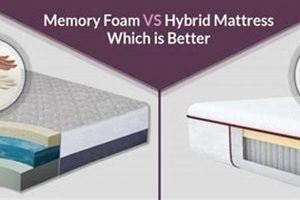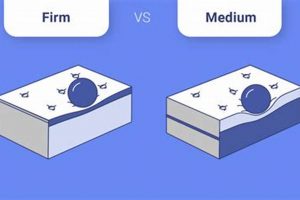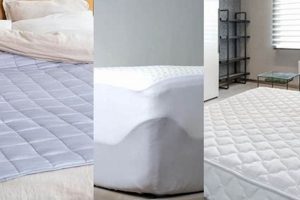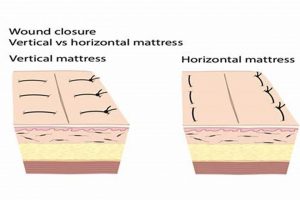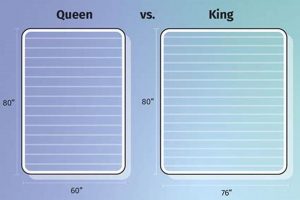The variance in depth between a thinner and a thicker sleeping surface significantly impacts support and comfort levels. A shallower option, typically six inches, offers minimal cushioning, while a deeper, eight-inch profile provides increased material for pressure relief and conforming capabilities. These measurements refer to the overall thickness of the complete structure, from the top layer to the base.
The total height is crucial for proper spinal alignment and overall sleep quality. A greater vertical dimension usually equates to more layers of comfort materials, such as memory foam or latex, resulting in enhanced pressure distribution and reduced stress on joints. Historically, thinner versions were often chosen for budget constraints or space limitations, while their deeper counterparts were favored for enhanced luxury and longevity.
Understanding the characteristics and implications of these differences is key to selecting the optimal sleeping arrangement. The following sections will delve into specific factors such as suitability for different body types, construction materials, and the effect on the overall sleep experience.
Considerations for Choosing Mattress Thickness
Selecting the appropriate mattress thickness is vital for optimal sleep posture and support. Evaluating individual needs and preferences is essential before making a decision regarding either a shallower or deeper profile.
Tip 1: Evaluate Body Weight: Individuals with higher body weights generally require a thicker mattress to ensure adequate support and prevent bottoming out. A shallower profile may not provide sufficient compression resistance.
Tip 2: Consider Sleep Position: Side sleepers typically benefit from increased mattress thickness to cushion the shoulders and hips, promoting spinal alignment. Back and stomach sleepers may find a thinner mattress adequate, provided the support core is firm.
Tip 3: Assess Frame Compatibility: The height of the mattress in relation to the bed frame affects the overall bed height. Ensure the selected thickness allows for comfortable entry and exit from the bed, especially for individuals with mobility concerns.
Tip 4: Understand Material Density: A thicker mattress does not automatically guarantee superior quality. Evaluate the density of the materials used, as higher density materials generally offer better support and durability, even in a thinner profile.
Tip 5: Account for Budget: Generally, thicker mattresses tend to be more expensive due to the increased material volume. Factor in budgetary constraints when comparing options, and prioritize material quality within the available budget.
Tip 6: Examine Layer Construction: The composition and arrangement of layers within a mattress affect its overall performance. Consider the combination of comfort layers (e.g., memory foam, latex) and support layers (e.g., innersprings, high-density foam) to achieve the desired feel.
Tip 7: Be aware of edge support: Thicker mattresses usually offer better edge support, preventing sagging at the perimeter and increasing the usable sleep surface.
Selecting the appropriate vertical dimension ultimately depends on a comprehensive assessment of personal needs and preferences. Prioritizing support, comfort, and durability will contribute to a more restful and restorative sleep experience.
The following sections will delve into specific material compositions and their effect on the overall performance and longevity of mattresses of varying depths.
1. Support Requirements
Support requirements directly influence the choice between a six-inch and an eight-inch mattress. Mattress depth correlates with the ability to provide adequate support, especially for individuals with specific needs. Insufficient support leads to spinal misalignment, pressure point discomfort, and disrupted sleep. For example, a heavier individual or someone with back pain often requires a thicker mattress to prevent sinking and maintain proper spinal alignment. A six-inch mattress may lack the necessary density or coil system to adequately support these individuals, while an eight-inch mattress, with its increased material and potentially more robust construction, offers a greater chance of meeting those heightened support requirements.
The construction materials also play a critical role. A six-inch mattress composed of high-density foam may provide adequate support for a lighter individual or a child. Conversely, an eight-inch mattress might incorporate a combination of supportive innersprings and cushioning foam layers. The optimal choice depends on the interaction between body weight, sleep position, and the materials within the mattress. Understanding these factors allows for a more tailored selection process, ensuring that the mattress effectively addresses individual support needs.
Ultimately, aligning mattress depth with support needs is a critical factor for a restful and restorative sleep experience. Ignoring support requirements can lead to chronic pain, sleep disturbances, and a reduced quality of life. Carefully evaluating individual support needs in conjunction with the construction and depth of the mattress provides a higher likelihood of selecting an appropriate sleep surface.
2. Body Weight
Body weight serves as a crucial determinant in selecting an appropriate mattress depth. The capacity of a mattress to adequately support the sleeper’s weight directly influences spinal alignment, pressure distribution, and overall comfort. Consequently, individuals must consider their body weight when evaluating the suitability of a six-inch versus an eight-inch mattress.
- Compression and Support
Higher body weights exert greater compressive forces on the mattress. A six-inch mattress may lack the necessary material volume and density to withstand these forces, leading to excessive sinkage and a loss of support. This can result in spinal misalignment, particularly for side sleepers, and increased pressure on heavier body parts. Conversely, an eight-inch mattress, with its increased thickness and potentially denser core, offers improved resistance to compression, providing more consistent support for heavier individuals.
- Material Density and Durability
Mattresses are constructed from varying densities of foam and/or coil systems. The ability of these materials to maintain their structural integrity under sustained pressure is directly related to their density. A lighter individual might find adequate support from a six-inch mattress with moderate density materials. However, a heavier person requires higher density materials to prevent premature sagging and degradation, which are more commonly found in eight-inch or thicker mattresses. This translates to a longer lifespan for the mattress and sustained support over time.
- Pressure Point Relief
Body weight also impacts pressure distribution. Heavier individuals experience concentrated pressure points on areas such as the hips and shoulders, especially when side sleeping. A thicker mattress allows for more generous comfort layers, such as memory foam or latex, which conform to the body’s contours and distribute weight more evenly, alleviating pressure points. A six-inch mattress may offer insufficient cushioning, leading to discomfort and potential joint pain.
- Weight Distribution and Spinal Alignment
Proper spinal alignment is essential for restful sleep and preventing back pain. A mattress must adequately support the body’s natural curves, preventing the spine from collapsing or bowing. For individuals with higher body mass, a thicker mattress is often necessary to provide this level of support. The increased material allows for a more sophisticated construction, incorporating zoned support systems that target specific areas of the body to maintain optimal spinal alignment throughout the night.
In summary, body weight is a primary factor in determining the appropriate mattress depth. A six-inch mattress may suffice for lighter individuals, but heavier sleepers typically require the enhanced support, durability, and pressure relief offered by an eight-inch or thicker mattress. Failure to account for body weight can result in discomfort, poor sleep quality, and premature mattress degradation, highlighting the importance of careful consideration during the selection process.
3. Spinal Alignment
Maintaining proper spinal alignment during sleep is paramount for musculoskeletal health and overall sleep quality. The chosen mattress plays a pivotal role in achieving this alignment, and the thickness of the mattress, specifically the difference between a six-inch and an eight-inch profile, can significantly impact its effectiveness in supporting the spine’s natural curves.
- Support Layer Integrity
The support core of a mattress is responsible for providing the necessary resistance to maintain spinal alignment. A six-inch mattress, particularly those with lower-density foam cores, may compress excessively under body weight, leading to spinal curvature or sagging. In contrast, an eight-inch mattress typically offers a more robust support core, capable of withstanding greater pressure and maintaining a neutral spinal position, especially for individuals with higher body mass or those who sleep on their sides.
- Pressure Point Accommodation
A mattress that fails to adequately accommodate pressure points can force the sleeper to adopt unnatural sleeping postures, compromising spinal alignment. Thicker mattresses, such as those with an eight-inch profile, often incorporate multiple layers of varying densities to distribute weight and reduce pressure on sensitive areas like the hips and shoulders. This contouring effect allows the spine to maintain its natural curves, promoting relaxation and minimizing discomfort. A six-inch mattress may lack the layering necessary to achieve this level of pressure relief, potentially leading to spinal misalignment and related aches.
- Sleep Position Adaptability
Different sleep positions require varying levels of support to maintain proper spinal alignment. Side sleepers generally benefit from a thicker mattress that allows the shoulder and hip to sink in slightly, keeping the spine straight. Back sleepers need a mattress that provides consistent support across the entire back, preventing the hips from sinking too far. Stomach sleepers require a firmer surface to prevent excessive arching of the lower back. An eight-inch mattress can often accommodate a wider range of sleep positions due to its increased support and contouring capabilities, while a six-inch mattress may be more suitable for specific sleep positions and body types.
- Edge Support Stability
Edge support refers to the firmness and stability of the mattress perimeter. Inadequate edge support can cause the sleeper to roll towards the edge of the bed, disrupting spinal alignment and potentially leading to falls. Thicker mattresses generally offer better edge support due to their increased material volume and reinforced construction. This provides a more stable and consistent sleep surface, reducing the risk of misalignment and promoting a more restful night’s sleep. A six-inch mattress may exhibit weaker edge support, particularly over time, increasing the likelihood of spinal misalignment.
The connection between spinal alignment and mattress thickness is multifaceted, encompassing support layer integrity, pressure point accommodation, sleep position adaptability, and edge support stability. While a six-inch mattress may suffice for certain individuals, an eight-inch mattress typically offers a greater capacity to maintain proper spinal alignment across a wider range of body types and sleep positions. Careful consideration of these factors is essential when selecting a mattress to ensure optimal musculoskeletal health and sleep quality.
4. Material Composition
The constituents comprising a mattress dictate its performance characteristics, with material composition exhibiting a direct correlation to the suitability of either a six-inch or eight-inch mattress for individual needs. Material density, resilience, and layering significantly influence support, comfort, and longevity.
- Foam Density and Support
Foam density, measured in pounds per cubic foot (PCF), is a critical determinant of support and durability. Higher density foams offer greater resistance to compression and maintain their structural integrity over time. A six-inch mattress utilizing low-density foam may exhibit premature sagging, particularly under higher body weights. An eight-inch mattress affords the opportunity to incorporate higher density foams, providing enhanced support and prolonging the mattress’s lifespan. For example, a six-inch memory foam mattress with 3 PCF foam may offer inadequate support compared to an eight-inch mattress with 5 PCF foam.
- Coil System and Edge Support
For innerspring mattresses, the coil gauge and coil count influence support and motion isolation. Thicker gauge coils offer greater resistance to compression, while a higher coil count contributes to more even weight distribution. An eight-inch innerspring mattress can accommodate a more robust coil system, providing superior support and edge reinforcement compared to a six-inch counterpart. Edge support, in particular, is often compromised in thinner mattresses due to space limitations for reinforcement materials. The edge support and support can prevent sinking or collapse around the edges when sitting or sleeping near the edge.
- Comfort Layer Materials and Pressure Relief
Comfort layers, such as memory foam, latex, or fiberfill, contour to the body and alleviate pressure points. An eight-inch mattress allows for thicker and more elaborate comfort layers, providing enhanced pressure relief and a more luxurious feel. A six-inch mattress often necessitates thinner comfort layers, potentially compromising comfort and pressure distribution. For instance, an eight-inch mattress may incorporate a two-inch layer of memory foam for contouring, while a six-inch mattress may only accommodate a one-inch layer, resulting in a less conforming sleep surface.
- Construction and Layering Configuration
The arrangement and combination of materials within a mattress affect its overall performance. An eight-inch mattress allows for more complex layering configurations, enabling manufacturers to fine-tune the balance between support, comfort, and temperature regulation. A six-inch mattress, due to its limited thickness, restricts layering options, potentially sacrificing certain performance characteristics. Examples of layered configurations will allow you to have more pressure and relief. For instance, an eight-inch mattress might feature a support core, a transition layer of responsive foam, and a top layer of plush memory foam, while a six-inch mattress may only offer a single layer of foam over a support core.
Material choices and their configuration are directly linked to the overall feel and performance of a mattress, significantly impacting the suitability of a six-inch versus an eight-inch model for various sleepers. The ability to incorporate higher density materials, more robust coil systems, and more elaborate layering configurations within an eight-inch mattress often translates to enhanced support, comfort, and longevity compared to its thinner counterpart.
5. Budget Constraints
Budget constraints represent a significant factor influencing consumer choices regarding mattress thickness. The interplay between financial limitations and desired sleep quality often necessitates a compromise, directly impacting the decision between a six-inch and an eight-inch mattress.
- Initial Purchase Price
The initial cost of a mattress is a primary consideration for budget-conscious consumers. Generally, six-inch mattresses possess a lower price point compared to their eight-inch counterparts due to the reduced material volume and simpler construction. This cost differential can be particularly appealing to individuals with limited funds or those furnishing temporary residences. For instance, a basic six-inch innerspring mattress might cost significantly less than a comparable eight-inch model with additional comfort layers. However, the long-term cost-effectiveness requires further evaluation.
- Material Quality Trade-offs
To maintain affordability, manufacturers may employ lower-quality materials in thinner mattresses. A six-inch mattress, to achieve a lower price point, might utilize lower density foams or a less robust coil system compared to an eight-inch model. These trade-offs can compromise support, durability, and overall comfort. While the initial saving might seem attractive, the premature degradation of lower-quality materials could necessitate earlier replacement, ultimately negating the initial cost advantage. Consider a six-inch mattress with a 2 PCF foam versus an eight-inch mattress with 4 PCF foam and its impact on support.
- Longevity and Replacement Costs
The lifespan of a mattress is directly influenced by its construction and material quality. A six-inch mattress constructed with inexpensive materials may exhibit sagging, compression, or coil failure within a shorter timeframe than an eight-inch mattress made with higher-quality components. The need for frequent replacements translates into increased long-term costs, diminishing the initial savings. A consumer may save $100 upfront buying a 6-inch cheaper mattress but pay 2x the price after two years if it needs to be replaced.
- Health and Comfort Considerations
Compromising on mattress thickness due to budget constraints can have implications for sleep quality and physical health. Inadequate support can lead to spinal misalignment, pressure point discomfort, and disrupted sleep. These issues can, in turn, contribute to daytime fatigue, reduced productivity, and even chronic pain. While a six-inch mattress may be the only financially feasible option for some, understanding the potential long-term health consequences is essential. The trade-off must consider the impact on overall well-being versus the upfront cost savings.
Budget constraints invariably influence the decision between a six-inch and an eight-inch mattress. While the lower initial cost of a thinner mattress may be appealing, consumers must carefully consider the potential trade-offs in material quality, longevity, and health implications. A thorough evaluation of long-term costs and personal needs ensures a more informed decision, balancing financial limitations with the desire for a comfortable and supportive sleep surface.
6. Bed Frame Compatibility
Bed frame compatibility exerts a significant influence on the selection process when considering a six-inch versus an eight-inch mattress. The chosen frame must adequately support the mattress, ensuring both its structural integrity and the sleeper’s comfort. An incompatible frame can lead to uneven weight distribution, premature mattress wear, and compromised sleep quality. For instance, a platform bed designed for thinner mattresses might not provide sufficient support for a thicker, eight-inch model, potentially resulting in sagging or an uncomfortably high sleeping surface. Conversely, a frame with deep recessed slats may render a six-inch mattress uncomfortably low, complicating entry and exit from the bed.
The height of the bed frame, combined with the mattress thickness, dictates the overall bed height. This dimension is crucial for ensuring ease of access, particularly for individuals with mobility limitations. A frame designed for standard mattress heights, when paired with an eight-inch mattress, may result in an excessively tall bed, posing challenges for some users. Conversely, using a six-inch mattress with a taller frame might create an uncomfortably low sleeping surface. Slat spacing is another critical factor. Widely spaced slats may not provide adequate support for any mattress, but the effect is more pronounced with thinner models, increasing the risk of sagging and premature wear. Platform beds, which offer continuous support, are generally more compatible with a wider range of mattress thicknesses. Adjustability features, such as adjustable bed frames, further complicate the compatibility assessment, as the frame’s articulation must not compromise the structural integrity of the mattress, particularly in thinner models.
In conclusion, bed frame compatibility is an essential consideration when selecting a mattress, with mattress thickness directly impacting the overall height and support provided. Selecting a frame that is appropriate for the planned mattress thickness ensures optimal support, longevity, and ease of use. Ignoring this aspect can result in discomfort, premature wear, and an unsuitable sleeping experience. Careful assessment of the bed frame’s design, slat spacing, and adjustability features is crucial for achieving a harmonious and supportive sleep environment, regardless of whether a six-inch or an eight-inch mattress is chosen.
7. Longevity Expectations
The expected lifespan of a mattress directly correlates with its construction, material quality, and intended usage, influencing the suitability of a six-inch versus an eight-inch profile. A consumer anticipating long-term use should prioritize durability, often favoring the typically more robust construction associated with thicker mattresses. For instance, a six-inch mattress composed of lower-density foam may exhibit premature sagging or compression, reducing its effective lifespan to a few years. Conversely, an eight-inch mattress with higher-density foam and a reinforced coil system is likely to provide sustained support and comfort over a significantly longer period, potentially exceeding a decade with proper care. The initial cost savings of a thinner mattress might be offset by the need for more frequent replacements, making the thicker option a more economically sound choice in the long run. Ultimately, evaluating longevity expectations is crucial for optimizing value and ensuring consistent sleep quality.
Practical applications of understanding this connection extend to various scenarios. In residential settings, where mattresses are often subjected to daily use by adults, prioritizing longevity is paramount. An eight-inch mattress featuring a multi-layered construction, including a high-density support core and pressure-relieving comfort layers, becomes a worthwhile investment. Alternatively, in guest rooms or children’s bedrooms where usage is less frequent, a six-inch mattress may prove sufficient, provided that material quality is not drastically compromised. Furthermore, institutions such as hotels or dormitories, which manage large quantities of mattresses, must carefully weigh the trade-off between upfront cost and long-term durability. A comprehensive cost-benefit analysis, factoring in replacement cycles and potential negative impacts on customer satisfaction or student well-being, can guide the selection process. Consider a university dorm that replaces its mattresses every four years to uphold a comfortable sleeping environment for its students. If they are using six-inch mattresses with poor quality, this would significantly reduce the bed quality compared to when eight-inch mattresses are being used.
In summary, longevity expectations serve as a critical decision-making criterion when evaluating mattress thickness. Thicker mattresses, generally, offer enhanced durability and sustained support due to increased material volume and the potential for higher-quality construction. However, the initial cost investment must be carefully weighed against the anticipated lifespan, usage patterns, and individual requirements. Challenges in this evaluation include accurately assessing material quality and predicting future usage patterns. Ultimately, aligning mattress selection with realistic longevity expectations maximizes value and ensures a consistent and comfortable sleep experience over the long term.
Frequently Asked Questions
This section addresses common inquiries and misconceptions surrounding the selection of mattresses based on thickness, specifically focusing on the distinctions between six-inch and eight-inch models. The information provided is intended to inform purchasing decisions, taking into account factors such as support, comfort, and longevity.
Question 1: Is a thicker mattress always better?
Not necessarily. Mattress performance depends on the quality and density of materials used, not solely on thickness. A six-inch mattress with high-density foam can provide adequate support, while an eight-inch mattress with low-density foam may offer insufficient support.
Question 2: How does body weight influence the choice of mattress thickness?
Higher body weights generally require a thicker mattress to prevent excessive compression and maintain spinal alignment. Individuals with lower body weights may find a six-inch mattress adequate, provided it offers sufficient support.
Question 3: Are six-inch mattresses suitable for adults?
Six-inch mattresses can be suitable for adults, depending on their body weight, sleep position, and individual support needs. However, they may not provide the same level of comfort and support as thicker mattresses, particularly for side sleepers or those with back pain.
Question 4: What type of bed frame is compatible with a thinner mattress?
Thinner mattresses are typically compatible with platform beds or frames with closely spaced slats. Frames with widely spaced slats may not provide adequate support, potentially leading to sagging.
Question 5: Does mattress thickness affect temperature regulation?
Indirectly, yes. Thicker mattresses often incorporate more layers, which can influence airflow and heat retention. The specific materials used in the comfort and support layers are more directly responsible for temperature regulation.
Question 6: How does the choice between a six-inch and eight-inch mattress impact longevity?
In general, thicker mattresses tend to have a longer lifespan due to the increased material volume and potential for higher-quality construction. However, material quality is the primary determinant of longevity, regardless of thickness.
The key takeaway is that mattress thickness is merely one factor among many that contribute to overall comfort, support, and longevity. A comprehensive evaluation of individual needs, material quality, and construction techniques is essential for making an informed purchasing decision.
The subsequent section will delve into a comparative analysis of specific mattress models, highlighting the advantages and disadvantages of each in relation to thickness and overall performance.
Concluding Assessment
The preceding analysis elucidates the critical distinctions between a six-inch and an eight-inch mattress, emphasizing the interconnectedness of thickness, material composition, support requirements, and individual preferences. The data presented underscores that the optimal choice is not solely determined by depth but rather by a holistic assessment of various factors. A six-inch mattress can provide adequate support for individuals with specific needs and constraints, while an eight-inch mattress often offers enhanced comfort and durability. Ultimately, the selection requires a thorough understanding of the trade-offs between initial cost, long-term performance, and individual sleep requirements.
Prospective buyers are encouraged to engage in informed decision-making by carefully evaluating their personal needs and prioritizing material quality and construction techniques over solely focusing on dimensions. Further research, including in-person testing and expert consultations, is advisable to ensure the selected mattress aligns with long-term health and well-being goals. The pursuit of optimal sleep quality warrants a considered approach, acknowledging that the proper mattress represents a significant investment in personal health and productivity.



